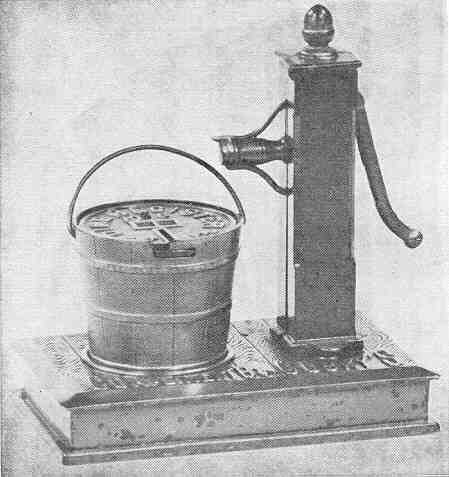Pump and Bucket Bank
by F.H. Griffith - HOBBIES Magazine - April, 1962

A mechanical bank that was not only sold commercially through the
regular trade channels, but was also given away as a complimentary item, is our choice as
No. 102 in the numerical classification of mechanical banks. This bank is the Pump and
Bucket, and the fact that it was given as a complimentary item by a store is all the more
unusual since the inscription bearing this out is inscribed on the bank itself. This means
that the concern that made the Pump and Bucket necessarily had a special pattern base
plate for the exclusive use of the store involved. In a mechanical bank this is a rather
unique circumstance. True the Weeden’s Plantation Savings Bank was sold commercially
and also given as a premium for selling subscriptions to certain magazines such as the
Youth’s Companion. All Plantation Banks, however, were regular production items with
no special markings. Whether or not the manufacturer of the Pump and Bucket made others
with special inscriptions for a number of different stores is not known. The specimen
pictured from his collection is the only one of its type ever seen by the writer to date.
Naturally and logically there were numbers of this same type produced for the store during
the period of its distribution as a gift advertising item.
The bank pictured was obtained by the writer a few years ago from an
antique dealer exhibiting in an antique show in Ligonier, Pa. It is in very fine original
condition with most of the original paper label on the underside of the bank.
Unfortunately this label does not show the manufacturer or the date the bank was made.
The label explains how to set the bank, the operation, that it can be opened when $5 in
dimes has been deposited, and so on. The original name of the bank according to the label
was the Pump Registering Bank, and it explains further that it is "Guaranteed If Not
Misused."
The writer has no old catalogs or information of any kind that would lead to the name of the company that made the Pump and Bucket. Also, to the best of the writer’s knowledge, there are no patent papers that cover the bank. On the top section lid of the bucket is inscribed "Pat. Apd.," but this is not helpful in any fashion and does not necessarily indicate that a patent was ever granted. Logically the writer feels that the Pump and Bucket was made by some concern who more or less specialized in making registering banks of the more conventional type such as buckets, kettles, trunks and buildings.
This brings to mind that the writer receives letters from time to time suggesting that one or another of the various types of the foregoing mentioned conventional registering banks should be classified as a mechanical bank. A registering bank that simply designates the amount of money deposited is not a mechanical bank in the accepted definition of what the terminology "mechanical bank" has come to mean. A registering bank as such does admittedly have mechanism, but that in itself does not bring it into the class of a mechanical bank. There is a fine line of demarcation and the Pump and Bucket is a typical example. In operating this bank a dime is placed in the proper section in the lid of the bucket, moving the pump handle up and down causes the coin to register and drop on into the bucket and base of the bank. The fact that the operating mechanism is in conjunction with a pump and handle places this bank in the mechanical bank category, and not just the conventional registering type group. Of course it is also a registering bank, but please note that if there were no registering mechanism on the Pump and Bucket Bank it would still be a mechanical bank since the coin would drop into the bucket only when the pump handle was operated.
The Pump and Bucket Bank shown is in good original paint condition. The pump is green with a gold acorn on top, the spout and handle are silver, and there is other silver and gold outlining on the pump. The bucket and top part of the base platform are nickel plated and the section of the bank under the platform is bright red. On the lid of the bucket appears the wording "Dime Register" and in smaller letters "Pat. Apd." Along the top length of the platform is the wording "Compliments of Gusky’s." This platform, by the way, is cast to represent wood type graining on boards.
Gusky’s was Pittsburgh’s first department store and a very unusual type of store whose background bears out the fact of the Pump and Bucket being given away as a complimentary item. Jacob Mark Gusky, a Pittsburgh philanthropist, opened his store in 1880 and it was located in Downtown Pittsburgh on Market Street between Third and Fourth Avenue. Any boy whose father bought a suit at Gusky’s could expect a toy for himself. Every Christmas a line of horse drawn buggies pulled up to the store to be filled with toys for distribution to underprivileged children. This was a generous policy of the store as established under Jacob Gusky. He was a hard industrious worker, charitable and generous, and at one time had 500 people in his employ. He died at the early age of 45 in the year 1886. The store business was continued after his death by his widow and other relatives for a time and then other small business concerns moved into the building, The last connection of the name Gusky with the store was between 1903 and 1904, and in that period Gusky’s in its final stages with about 15 remaining employees went out of business.
A tablet in memory of Jacob Mark Gusky hangs in his honor in the rotunda of the Pittsburgh Courthouse.
